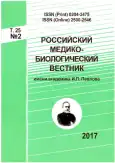MIGRATION OF THE INTRAUTERINE DEVICE TO THE ABDOMINAL CAVITY
- Issue: Vol 25, No 2 (2017)
- Pages: 247-262
- Section: Articles
- URL: https://journals.rcsi.science/pavlovj/article/view/7000
- DOI: https://doi.org/10.23888/PAVLOVJ20172247-262
- ID: 7000
Cite item
Abstract
The aim: demonstration of our experience of surgical treatment of patients with migrated intrauterine device (IUD) into the abdominal cavity.
The results of surgical treatment of migrated IUDs in the pelvic cavity are summarized in 17 women. The average age of the patients was 33,2±3,4 years. The timing of implantation of the IUDs varied from 10 days to 24 months. In all cases, the intra operational finding was T-shaped a copper device.
The reason behind the women's consultation was an increase in pain syndrome in the lesser pelvis (n=15), dysuric phenomenon (n=1) and the onset of pregnancy (n=1). Perforation of the uterus and migration of the spiral occurred from 10 days to 2 years after its implantation. All patients were operated laparoscopicaly.
The average duration of operations was 45,5±10,5 minutes. In the postoperative period there were no complications from the pelvic organs and postoperative wounds. The period of hospitalization of patients was 3,5±0,7 days. In all cases there was a regression of clinical signs and recovery. In one pregnant patient (gestation period 5-6 weeks) the pregnancy proceeded without particular pathological abnormalities and resulted in the birth of a full-term child.
Laparoscopic removal of the IUD migrating from the uterine cavity to the abdominal cavity is the method of choice in the treatment of this group of patients, avoiding development of intra- and postoperative complications and a shorter length of stay in the hospital. The effectiveness of the procedure reaches 100%. The most common cause of complication of the IUD is the perforation of the uterus during its implantation.
Full Text
##article.viewOnOriginalSite##References
- United Nations, Population Division, Dept. of Economic and Social Affairs. World Contraceptive Use 2007. New York, NY, USA; 2008.
- Adiyeke M, Sanci M, Karaca i, Gokgu M, Toz E, Ocal E. Surgical management of intrauterine devices migrated towards intra-abdominal structures: 20-year experience of a tertiary center. Clin Exp Ob- stet Gynecol. 2015; 42 (3): 358-360. doi: 10.12891/ceog1840.2015.
- Kimberly A Kho, Dina J. Perforated intraperitoneal intrauterine contraceptive devices: diagnosis, management, and clinical outcomes. Chamsy Journal of Minimally Invasive Gynecology. 2014; 21: 596-601.
- Arslan A, Kanat-Pektas M, Yesi- lyurt H, Bilge U. Colon penetration by a copper intrauterine device: a case report with literature review. Archives of Gynecology and Obstetrics. 2009; 279 (3): 395-397.
- Ertopcu K, Nayki C, Ulug P, Nayki U, Gultekin E, Donmez A et al. Surgical removal of intra-abdominal intrauterine devices at one center in a 20-year period. Int J Gynaecol Obstet. 2015; 128 (1): 10-13. doi: 10.1016/j.ijgo.2014.07.025.
- Soydinc HE, Evsen Ms, Caga F, Sak ME, Taner MZ, Sak S. Translocated intrauterine contraceptive device: experiences of two medical centers with risk factors and the need for surgical treatment. J Reprod Med. 2013; 58 (5-6): 234-240.
- Ganer H, Levy A, Ohel I, Sheiner E. Pregnancy outcome in women with an intrauterine contraceptive device. Am J Obstet Gynecol. 2009; 201 (4): 381. e1-381.e5.
- Koetsawang S, Rachawat D, Piya- Anant M. Outcome of pregnancy in the presence of intrauterine device. Acta Obstet Gynecol Scand. 1977; 56 (5): 479-482.
- Andersson K, Ryde-Blomqvist E, Lindell K, Odlind V, Milsom I. Perforations with intrauterine devices: report from a Swedish survey. Contraception. 1998; 57 (4): 251-255.
- Caliskan E, Ozturk N, Dilbaz BO, Dilbaz S. Analysis of risk factors associated with uterine perforation by intrauterine devices. Eur J Contracept Reprod Health Care. 2003; 8 (3): 150-155.
- Long-term reversible contraception: twelve years of experience with the TCu380A and TCu220C. Contraception. 1997; 56 (6): 341-352.
- World Health Organization. WHO mechanism of action, safety, and efficacy of intrauterine devices. Geneva, Switzerland: World Health Organization; 1987. P. 48-63.
- Cetinkaya K, Kumtepe Y, Ingec M. Minimally invasive approach to cases of lost intra-uterine device: a 7-year experience. Eur J Obstet Gynecol Reprod Biol. 2011; 159 (1): 119-121. doi: 10.1016/j.ejogrb.2011.07.003.
- Le A, Shan L, Xiao T, Zhuo R, Wang Z. Removal of an incarcerated intrauterine device in the sigmoid colon under the assistance of hysteroscope and laparoscope: a case report. Clin Exp Obstet Gynecol. 2015; 42 (4): 531-534.
- Madden A, Aslam A, Nusrat NB. A Case of Migrating «Saf-T-Coil» Presenting with a Vesicovaginal Fistula and Vesicovaginal Calculus. Urol Case Rep. 2016; 23 (7): 17-19. doi: 10.1016/j.eucr.2016.03.014.e Collection 2016.
Supplementary files







